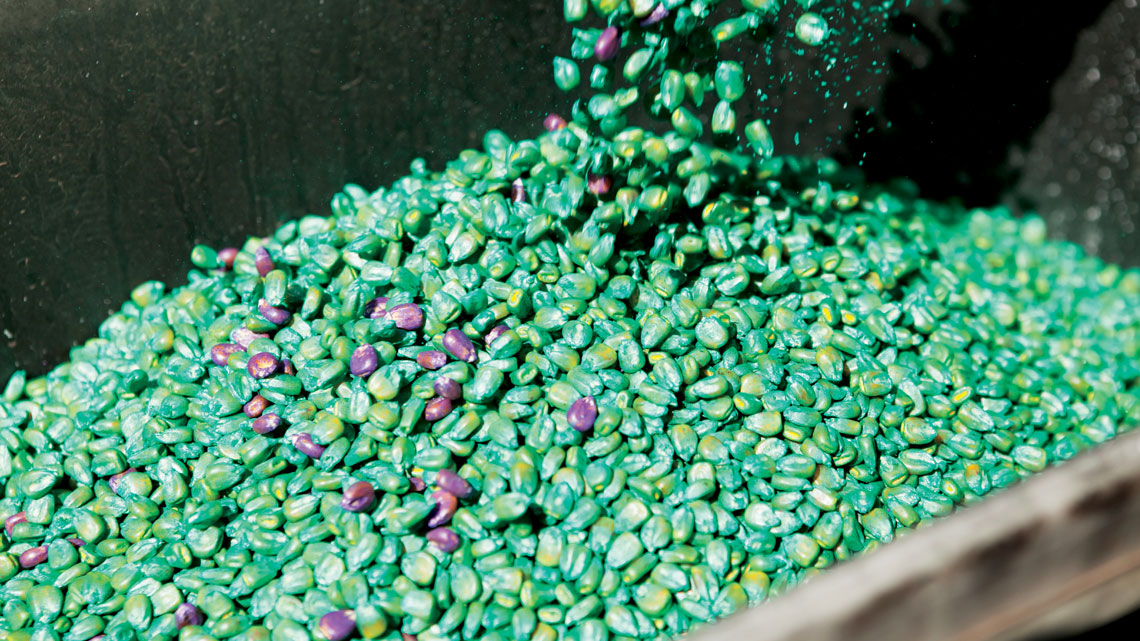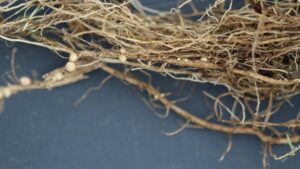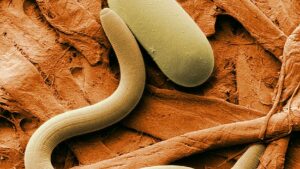New studies outline the benefits, or lack thereof, of seed treatment use in U.S. crop production.
Seed treatments have been around for more than 100 years, but it hasn’t been until the past decade that farmers have adopted the use of seed treatments across multiple crops and millions of acres.
The subject of much debate, government and industry are investing resources to research the advantages and disadvantages that seed treatments bring to agriculture. The proponents argue that seed treatments protect the seed and help to increase yield while minimizing the broad application of crop protectants. Meanwhile, the opponents report that seed treatments are detrimental to the environment and pose a risk to pollinators.
The U.S. Environmental Protection Agency released a report Oct. 16 that analyzed the use of neonicotinoid seed treatments for insect control in U.S. soybean production. The report, compiled by Clayton Myers, an entomologist in the Biological Analysis Branch, and Elizabeth Hill, an economist in the Economic Analysis Branch, discusses how the treatments are used, available alternatives and costs. From their analysis, EPA concluded that seed treatments provide little or no overall benefits to soybean production in most situations.
In the analysis, Myers and Hill report that from 2008 to 2012, an average of 76. 5 million acres of U.S. soybeans were harvested each year. Of those 76 million acres, an average of 31 percent were planted with neonicotinoid treated soybean seeds during that same time, according to the report. That’s more than 1 million pounds of active ingredient applied to seed each year to be planted beneath the soil surface.
Myers and Hill relied extensively on information provided by Extension specialists from a number of land-grant universities in high crop producing states, such as Indiana, Iowa, Minnesota, Mississippi, North Dakota and Pennsylvania.
In the report, the authors call attention to the limited bioactivity of seed treatments, which is three to four weeks from planting. EPA’s analysis took into account populations of soybean aphids, bean leaf beetle, cutworms and the three-cornered alfalfa hopper — a problem in the South.
Evaluating Pest Control
“EPA proprietary usage data, derived from grower pesticide usage surveys (2004-2012) indicate that when insect pests are explicitly targeted by seed treatments, the national leading target pests are soybean aphid and bean leaf beetle,” according to the Benefits of Neonicotinoid Seed Treatments to Soybean Production memorandum. “The pests were targets for seed treatments on approximately 20 percent of soybean acreage nationally from 2004 to 2012.”
In the grower pesticide usage surveys, 65 percent of growers did not indicate any specific target pest driving their usage of soybean neonicotinoid seed treatment products. As a result, Myers and Hill conclude that “much of the existing usage on soybeans is prophylactic.”
EPA will accept comments on its analysis until Dec. 22. Submit your comments by visiting regulations.gov.
As part of the analysis, 60 published comparisons were reviewed. “In the studies that included a comparison to foliar insecticides, there were no instances where neonicotinoid seed treatments out-performed any foliar insecticide in yield protection from any pest,” Myers and Hill write. “In the majority of cases, yield was not significantly different between plots treated with neonicotinoid seed treatments at planting versus those treated with foliar sprays. In the few instances where significant differences were reported, it was the foliar spray treatments that resulted in higher yields than soybeans with seed treatments.”
The exception where seed treatments might prove beneficial, based on the report, is the South. The authors noted a study from Louisiana that compared a number of seed treatments for yield protection from three-cornered alfalfa hopper and showed that an experimental thiamethoxam seed treatment (similar in active ingredient dosing to commercial products) did significantly protect yield. However, they cite that yields from eight other formulations of thiamethoxam and imidacloprid in the same study were not different than an untreated control.
“Given cropping practices, pest pressure considerations and the difficulty of scouting for pest pressure prior to planting, it appears at least plausible that insurance benefits of seed treatment usage could be higher for the southern U.S. growing region relative to the rest of the country,” Myers and Hill write.
“In the studies that included a comparison to foliar insecticides, there were no instances where neonicotinoids out-performed any foliar insecticide in yield protection.”
— Clayton Myers and Elizabeth Hill
They acknowledge that more information is needed to fully understand the benefits of neonicotinoid seed treatments on soybeans. These include understanding “whether significant ‘insurance’ benefits exist in the southern United States or elsewhere for prophylactic neonicotinoid seed treatment, including specific information on the yield impacts of sporadic pests and the corresponding impacts of preventative seed treatments on soybean yield.” Additionally, more information is needed to understand the consequences of neonicotinoid seed treatments in the broader soybean integrated pest management approach, how it impacts pesticide resistance management in soybeans and additional cost savings or expenditures for soybean production that were not adequately captured by the analysis.
More Than Beans
While EPA’s analysis focused solely on soybeans, a new study conducted by AgInfomatics LLC documents the value of neonicotinoids to agriculture and residential and urban landscapes, and the implications if these products were no longer available.
The study evaluated seed treatment, soil and foliar uses of neonicotinoid insecticides in the United States and Canada. Research included crops such as corn, soybeans, wheat, cotton, sorghum and canola, and specialty crops such as citrus, vegetables and grapes, plus turf, ornamental and landscape uses.
As the largest-selling insecticide class in the world, some have questioned the value of neonicotinoids. This study was undertaken to provide reliable, objective evidence of the benefits these products bring to modern pest management systems.
Research results prove that neonicotinoids add billions of dollars to the economy, and benefit entire communities — not just individual growers. In addition, research shows a loss of neonicotinoids would force growers to rely on a few, older classes of insecticides. More foliar sprays of broad-spectrum insecticides would be used in place of targeted seed or soil treatments. Across selected commodity crops evaluated, the study found that each pound of neonicotinoid lost would be replaced by nearly 5 pounds of older insecticides. The consequences of this change would result in reduced crop yield and quality, disrupted pest management practices impacting beneficial insects including honeybees and, in some cases, catastrophic damage due to a lack of suitable alternatives to manage invasive pests.
Researchers surveyed more than 22,000 growers, consumers and applicators in the United States and Canada, reviewed in-depth pesticide use information from leading data providers,
and conducted a meta-analysis of yield performance involving thousands of observations. The team also conducted listening sessions in eight locations across North America to gain user insights and complement the quantitative data.
“Although many know intuitively that this class of chemistry is highly valued within the industry, we now have a comprehensive, science-based analysis that documents the magnitude of this value,” says Pete Nowak, AgInfomatics principal and a University of Wisconsin-Madison environmental resources expert.
The research was jointly commissioned by Bayer CropScience, Syngenta and Valent, with additional support from Mitsui on the turf and ornamental studies.
To view the full report, visit growingmatters.org/case-studies/listening/.













